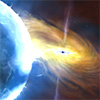 The explosion is more than ten times brighter than any known supernova and three times brighter than the brightest tidal disruption event, where a star falls into a supermassive black hole.
The explosion is more than ten times brighter than any known supernova and three times brighter than the brightest tidal disruption event, where a star falls into a supermassive black hole.
May 12th, 2023
Read more
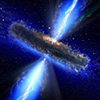 Astronomers have found that supermassive black holes obscured by dust are more likely to grow and release tremendous amounts of energy when they are inside galaxies that are expected to collide with a neighbouring galaxy.
Astronomers have found that supermassive black holes obscured by dust are more likely to grow and release tremendous amounts of energy when they are inside galaxies that are expected to collide with a neighbouring galaxy.
May 11th, 2023
Read more
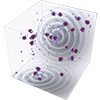 Researchers have discovered a new generic production mechanism of gravitational waves generated by a phenomenon known as oscillons, which can originate in many cosmological theories from the fragmentation into solitonic 'lumps' of the inflaton field that drove the early Universe's rapid expansion.
Researchers have discovered a new generic production mechanism of gravitational waves generated by a phenomenon known as oscillons, which can originate in many cosmological theories from the fragmentation into solitonic 'lumps' of the inflaton field that drove the early Universe's rapid expansion.
May 11th, 2023
Read more
 Astronomers have revealed new evidence about the properties of the giant bubbles of high-energy gas that extend far above and below the Milky Way galaxy's center.
Astronomers have revealed new evidence about the properties of the giant bubbles of high-energy gas that extend far above and below the Milky Way galaxy's center.
May 9th, 2023
Read more
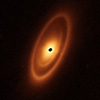 Astronomers imaged the warm dust around a nearby young star, Fomalhaut, in order to study the first asteroid belt ever seen outside of our solar system in infrared light. But to their surprise, the dusty structures are much more complex than the asteroid and Kuiper dust belts of our solar system.
Astronomers imaged the warm dust around a nearby young star, Fomalhaut, in order to study the first asteroid belt ever seen outside of our solar system in infrared light. But to their surprise, the dusty structures are much more complex than the asteroid and Kuiper dust belts of our solar system.
May 8th, 2023
Read more
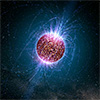 Scientists measured the masses of several key nuclei with high-precision by employing a state-of-the-art storage-ring mass spectrometry technique. Using the new mass data, they investigated X-ray bursts on the surface of a neutron star, thus deepening the understanding of neutron star properties.
Scientists measured the masses of several key nuclei with high-precision by employing a state-of-the-art storage-ring mass spectrometry technique. Using the new mass data, they investigated X-ray bursts on the surface of a neutron star, thus deepening the understanding of neutron star properties.
May 5th, 2023
Read more
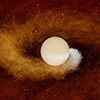 Scientists have observed hints of stars just before, and shortly after, the act of consuming entire planets, but they have never caught one in the act until now.
Scientists have observed hints of stars just before, and shortly after, the act of consuming entire planets, but they have never caught one in the act until now.
May 4th, 2023
Read more
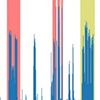 What would the Earth look like to an alien civilization located light years away?
What would the Earth look like to an alien civilization located light years away?
May 3rd, 2023
Read more
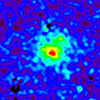 An initial study of dark energy with eROSITA indicates that it is uniformly distributed in space and time.
An initial study of dark energy with eROSITA indicates that it is uniformly distributed in space and time.
May 3rd, 2023
Read more
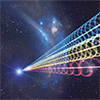 A team of astronomers has discovered 25 new sources of repeating fast radio bursts (FRBs), these explosions in the sky that come from far beyond the Milky Way. This discovery brings the total number of confirmed FRB sources to 50.
A team of astronomers has discovered 25 new sources of repeating fast radio bursts (FRBs), these explosions in the sky that come from far beyond the Milky Way. This discovery brings the total number of confirmed FRB sources to 50.
Apr 29th, 2023
Read more
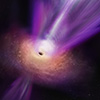 An international team of scientists has used new millimeter-wavelength observations to produce an image that shows, for the first time, both the ring-like accretion structure around a black hole, where matter falls into the black hole, and the black hole's associated powerful relativistic jet.
An international team of scientists has used new millimeter-wavelength observations to produce an image that shows, for the first time, both the ring-like accretion structure around a black hole, where matter falls into the black hole, and the black hole's associated powerful relativistic jet.
Apr 26th, 2023
Read more
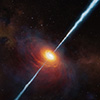 Scientists have unlocked one of the biggest mysteries of quasars - the brightest, most powerful objects in the Universe - by discovering that they are ignited by galaxies colliding.
Scientists have unlocked one of the biggest mysteries of quasars - the brightest, most powerful objects in the Universe - by discovering that they are ignited by galaxies colliding.
Apr 26th, 2023
Read more
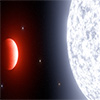 The rare metal terbium has been found in an exoplanet's atmosphere for the first time. The researchers have also developed a new method for analyzing exoplanets, making it possible to study them in more detail.
The rare metal terbium has been found in an exoplanet's atmosphere for the first time. The researchers have also developed a new method for analyzing exoplanets, making it possible to study them in more detail.
Apr 26th, 2023
Read more
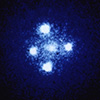 A team of astrophysicists has provided the most direct evidence yet that Dark Matter does not constitute ultramassive particles as is commonly thought but instead comprises particles so light that they travel through space like waves.
A team of astrophysicists has provided the most direct evidence yet that Dark Matter does not constitute ultramassive particles as is commonly thought but instead comprises particles so light that they travel through space like waves.
Apr 25th, 2023
Read more
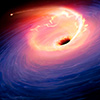 'Scary Barbie' is the affectionate nickname astronomers are calling one of the most energetic and luminous transients ever observed: a supermassive black hole tearing apart a massive star.
'Scary Barbie' is the affectionate nickname astronomers are calling one of the most energetic and luminous transients ever observed: a supermassive black hole tearing apart a massive star.
Apr 25th, 2023
Read more
 Simulations capture the interaction between a rocket plume and the surface and find ways to make planetary descents and ascents safer.
Simulations capture the interaction between a rocket plume and the surface and find ways to make planetary descents and ascents safer.
Apr 25th, 2023
Read more
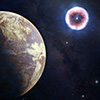 An exploded star can pose more risks to nearby planets than previously thought, according to a new study from NASA's Chandra X-ray Observatory and other X-ray telescopes.
An exploded star can pose more risks to nearby planets than previously thought, according to a new study from NASA's Chandra X-ray Observatory and other X-ray telescopes.
Apr 21st, 2023
Read more
 Astronomers pinpointed the location of the brightest cosmic explosion ever recorded was pinpointed at 2.4 billion light years from Earth.
Astronomers pinpointed the location of the brightest cosmic explosion ever recorded was pinpointed at 2.4 billion light years from Earth.
Apr 13th, 2023
Read more
 The explosion is more than ten times brighter than any known supernova and three times brighter than the brightest tidal disruption event, where a star falls into a supermassive black hole.
The explosion is more than ten times brighter than any known supernova and three times brighter than the brightest tidal disruption event, where a star falls into a supermassive black hole.
 Subscribe to our Space Exploration News feed
Subscribe to our Space Exploration News feed















